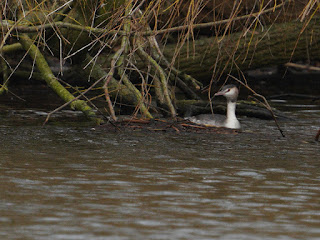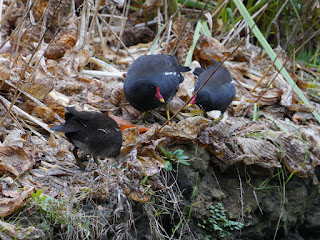For several days I've been hearing a Green Woodpecker calling, on both sides of the Long Water but it's probably the same bird as they move around a lot. Here it is on Buck Hill.
The female Little Owl was in the usual tree but even harder to see than usual. If you want to get a better view I'd advise going as it begins to get dark and they emerge to start hunting when the people and dogs are gone.
A Redwing waited in the top of a rowan tree to go down and pick fruit from the lower branches, where there is still some left after several days of serious feeding.
The resident Mistle Thrush waited in an adjacent tree. It seems to leave Redwings in peace, but if a Jay or a Magpie landed in the tree the thrush would attack it furiously.
There is often a Pied Wagtail on the Serpentine Gallery, attracted by the slate roof in whose crevices insects lurk.
It's the same story at the small boathouse with a roof of heavy green slates.
A Robin sang in the Rose Garden, raising its voice to be heard over the din of the funfair.
A Long-Tailed Tit was part of a mixed flock looking for insects in brambles near the Queen's Temple.
The Coal Tit in the Flower Walk followed me the whole way along. It seems to be storing the pine nuts it gets in the cedar tree at the back of the Albert Memorial.
This Black-Headed Gull, conspicuous by having gone into full breeding plumage very early, is always on or near the landing stage by the Diana fountain. When you notice a gull as an individual you see that it stays mostly in exactly the same spot. Their system of territories is mostly unnoticed by humans.
There is usually a Great Crested Grebe guarding the nest on the Long Water to stop Coots from claiming it. Judging by the nest's quite solid construction with plenty of twigs, it was built by Coots.
A procession of Coots moved up the edge of the Serpentine. At the last count there were 331 of them in the park, and numbers continue to rise.
The Moorhen family in the Dell poked around in a patch of dead leaves.
An Egyptian Goose on the Serpentine had a vigorous wash and a flap to settle its wings.
There were five species on the swan island in the Long Water: Cormorant, Herring Gull, Egyptian, Moorhen and Coot.
I keep hoping we'll see more rabbits in Kensington Gardens, but for months there have been only two. Today they were feeding together in their usual place beside the Henry Moore sculpture.













That left eye of that rabbit looks like cataract?
ReplyDeleteYes, I think so. When it first appeared I feared it was myxomatosis, but it hasn't got any worse in several months.
DeleteMy first thought,too. Hope not.
ReplyDeleteAll those Coots : soon it'll be like St James's Park - when they all sit together they look like a very large convention of nuns.
It was St James's Park where Coots were first introduced to central London in the early 1970s, by putting their eggs into Moorhens' nests. Like most introductions it was a disaster.
ReplyDeleteCoots look to me like Catholic priests bustling around the Vatican in their soutanes, as I used to see when I was in Rome around 1970. Often they spoke Ukrainian or Tagalog, and conversations had to be conducted in Latin, an interesting challenge.
Didn't know that. Where are Coots originally from?
ReplyDeleteDid Latin at school, but never had enough to have conversations. (just reading ancient texts, mostly under-interesting to the teenage mind) Never mind about scripture (or politics). Respect to those priests, for their linguistic skills.
The Eurasian Coot is a widespread species. It just wasn't an urban one.
DeleteInteresting to read what you wrote about Coots introduced in St. James's Park- not a story I'd heard before. Reading since in the Birds of London it does mention this though the species was wintering in London as a native species before this.
ReplyDeleteIt mentions Coot remains found from Roman London & says it was an uncommon resident in the 19th Century but more numerous in winter but more common than Moorhen.
New habitats have also been to the Coot's advantage. I'm not sure the actions of St. James's Park made much difference to current numbers as many other water birds that were formerly scarce (or non-existent) such as Heron, Cormorant, Great Crested Grebe, Tufted Duck have all increased.
Some of the sites I monitor have few Coots in winter these days- just one at Lonsdale Rd Reservoir, Barnes & only 10 on Pen Ponds this month. In the 80's I'd see maybe up to 100 at the former & 2-300 at the latter.
Good to see you have 2 Rabbits-let's hope they are separate sexes! A mammal that is in decline.
Finally let me wish you a Happy New Year & let's hope 2022 is an improvement on this year.
On the subject of Coots and Latin, their Latin and Greek names, fulica and phalaris, seem to hark back to i.e. bhal/bhol, "white", perhaps on account of their white frontal shield.
ReplyDeleteHappy New Year to all! From now on, the only way is up!
I must confess that we were discouraged from learning to speak Latin as if it was a modern language, although we were strongly encouraged to write it. It was drilled into our heads 'Latine loqui corrumpit ipsam latinitatem', 'to speak Latin destroys good Latin itself'.
Happy New Year to all! From now on, the only way is up.
It's curious, though, that the English words 'black' and 'bleach' seem to have the same root.
DeleteI wouldn't say that our Latin conversations were at a very high level. A typical exchange would be turning up in a village and wanting to see the church, and finding it locked. Quis tenet clavem ecclesiae? Ubi est ille? It worked.
A very happy New Year to you.